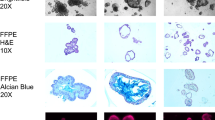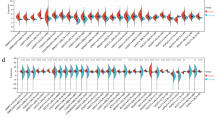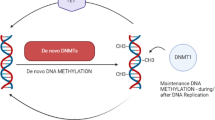Abstract
Chromatin remodeling and activation of transcription are important aspects of gene regulation, but these often go awry in disease progression, including during colon cancer development. We investigated the status of global histone acetylation (by measuring H3, H4 acetylation of lysine residues, which also occur over large regions of chromatin including coding regions and non-promoter sequences) and expression of histone deacetylase 2 (HDAC2) in colorectal cancer (CRC) tissue microarrays using immunohistochemical staining. Specifically, HDAC2 and the acetylation of histones H4K12 and H3K18 were evaluated in 134 colonic adenomas, 55 moderate to well differentiated carcinomas, and 4 poorly differentiated carcinomas compared to matched normal tissue. In addition, the correlation between expression of these epigenetic biomarkers and various clinicopathological factors including, age, location, and stage of the disease were analyzed. HDAC2 nuclear expression was detected at high levels in 81.9%, 62.1%, and 53.1% of CRC, adenomas, and normal tissue, respectively (P = 0.002). The corresponding nuclear global expression levels in moderate to well differentiated tumors for H4K12 and H3K18 acetylation were increased while these levels were decreased in poorly differentiated tumors (P = 0.02). HDAC2 expression was correlated significantly with progression of adenoma to carcinoma (P = 0.002), with a discriminative power of 0.74, when comparing cancer and non-cancer cases. These results suggest HDAC2 expression is significantly associated with CRC progression.



Similar content being viewed by others
References
Howe HL, Wingo PA, Thun MJ, et al. Annual report to the nation on the status of cancer (1973 through 1998), featuring cancers with recent increasing trends. J Natl Cancer Inst. 2001;93:824–842.
Jemal A, Siegel R, Ward E, et al. Cancer statistics, 2007. CA Cancer J Clin. 2007;57:43–66.
Troisi RJ, Freedman AN, Devesa SS. Incidence of colorectal carcinoma in the US: an update of trends by gender, race, age, subsite, and stage, 1975–1994. Cancer. 1999;85:1670–1676.
Ashktorab H, Smoot DT, Carethers JM, et al. High incidence of microsatellite instability in colorectal cancer from African Americans. Clin Cancer Res. 2003;9:1112–1117.
Ashktorab H, Smoot DT, Farzanmehr H, et al. Clinicopathological features and microsatellite instability (MSI) in colorectal cancers from African Americans. Int J Cancer. 2005;116:914–919. doi:10.1002/ijc.21062.
Carethers JM. Racial and ethnic factors in the genetic pathogenesis of colorectal cancer. J Assoc Acad Minor Phys. 1999;10:59–67.
Jass JR. Classification of colorectal cancer based on correlation of clinical, morphological and molecular features. Histopathology. 2007;50:113–130. doi:10.1111/j.1365-2559.2006.02549.x.
Tzao C, Sun GH, Tung HJ, et al. Reduced acetylated histone H4 is associated with promoter methylation of the fragile histidine triad gene in resected esophageal squamous cell carcinoma. Ann Thorac Surg. 2006;82:396–401. doi:10.1016/j.athoracsur.2006.03.066..
Jenuwein T, Allis CD. Translating the histone code. Science. 2001;293:1074–1080. doi:10.1126/science.1063127.
Marks PA, Richon VM, Breslow R, et al. Histone deacetylase inhibitors as new cancer drugs. Curr Opin Oncol. 2001;13:477–483. doi:10.1097/00001622-200111000-00010.
Bernstein BE, Meissner A, Lander ES. The mammalian epigenome. Cell. 2007;128:669–681. doi:10.1016/j.cell.2007.01.033.
Bernstein BE, Schreiber SL. Global approaches to chromatin. Chem Biol. 2002;9:1167–1173. doi:10.1016/S1074-5521(02)00265-X.
Cress WD, Seto E. Histone deacetylases, transcriptional control, and cancer. J Cell Physiol. 2000;184:1–16.
Liu Y, Colosimo AL, Yang XJ, et al. Adenovirus E1B 55-kilodalton oncoprotein inhibits p53 acetylation by PCAF. Mol Cell Biol. 2000;20:5540–5553. doi:10.1128/MCB.20.15.5540-5553.2000.
Liu Y, Tseng M, Perdreau SA, et al. Histone H2AX is a mediator of gastrointestinal stromal tumor cell apoptosis following treatment with imatinib mesylate. Cancer Res. 2007;67:2685–2692. doi:10.1158/0008-5472.CAN-06-3497.
Hubbert C, Guardiola A, Shao R, et al. HDAC6 is a microtubule-associated deacetylase. Nature. 2002;417:455–458. doi:10.1038/417455a.
de Ruijter AJ, van Gennip AH, Caron HN, et al. Histone deacetylases (HDACs): characterization of the classical HDAC family. Biochem J. 2003;370:737–749. doi:10.1042/BJ20021321.
Seligson DB, Horvath S, Shi T, et al. Global histone modification patterns predict risk of prostate cancer recurrence. Nature. 2005;435:1262–1266. doi:10.1038/nature03672.
Barlesi F, Giaccone G, Gallegos-Ruiz MI, et al. Global histone modifications predict prognosis of resected non small-cell lung cancer. J Clin Oncol. 2007;25:4358–4364. doi:10.1200/JCO.2007.11.2599.
Kondo Y, Shen L, Yan PS, et al. Chromatin immunoprecipitation microarrays for identification of genes silenced by histone H3 lysine 9 methylation. Proc Natl Acad Sci USA. 2004;101:7398–7403. doi:10.1073/pnas.0306641101.
Dashwood RH, Ho E. Dietary histone deacetylase inhibitors: from cells to mice to man. Semin Cancer Biol. 2007;17:363–369. doi:10.1016/j.semcancer.2007.04.001.
Satoh A, Toyota M, Itoh F, et al. DNA methylation and histone deacetylation associated with silencing DAP kinase gene expression in colorectal and gastric cancers. Br J Cancer. 2002;86:1817–1823. doi:10.1038/sj.bjc.6600319.
Sobin LH, Fleming ID. TNM Classification of malignant tumors, fifth edition (1997). Union Internationale Contre le Cancer and the American Joint Committee on Cancer. Cancer. 1997;80:1803–1804.
Hewitt SM. The application of tissue microarrays in the validation of microarray results. Methods Enzymol. 2006;410:400–415. doi:10.1016/S0076-6879(06)10020-8.
Zlobec I, Terracciano L, Jass JR, et al. Value of staining intensity in the interpretation of immunohistochemistry for tumor markers in colorectal cancer. Virchows Arch. 2007;451:763–769. doi:10.1007/s00428-007-0466-8.
Esteller M. CpG island hypermethylation and tumor suppressor genes: a booming present, a brighter future. Oncogene. 2002;21:5427–5440. doi:10.1038/sj.onc.1205600.
Ono S, Oue N, Kuniyasu H, et al. Acetylated histone H4 is reduced in human gastric adenomas and carcinomas. J Exp Clin Cancer Res. 2002;21:377–382.
Yasui W, Oue N, Ono S, et al. Histone acetylation and gastrointestinal carcinogenesis. Ann N Y Acad Sci. 2003;983:220–231.
Mitani Y, Oue N, Hamai Y, et al. Histone H3 acetylation is associated with reduced p21(WAF1/CIP1) expression by gastric carcinoma. J Pathol. 2005;205:65–73. doi:10.1002/path.1684.
Fahrner JA, Eguchi S, Herman JG, et al. Dependence of histone modifications and gene expression on DNA hypermethylation in cancer. Cancer Res. 2002;62:7213–7218.
Baylin SB, Esteller M, Rountree MR, et al. Aberrant patterns of DNA methylation, chromatin formation and gene expression in cancer. Hum Mol Genet. 2001;10:687–692. doi:10.1093/hmg/10.7.687.
Suzuki H, Ouchida M, Yamamoto H, et al. Decreased expression of the SIN3A gene, a candidate tumor suppressor located at the prevalent allelic loss region 15q23 in non-small cell lung cancer. Lung Cancer. 2008;59:24–31. doi:10.1016/j.lungcan.2007.08.002.
Jepsen K, Rosenfeld MG. Biological roles and mechanistic actions of co-repressor complexes. J Cell Sci. 2002;115:689–698.
Kim YS, Tsao D, Siddiqui B, et al. Effects of sodium butyrate and dimethylsulfoxide on biochemical properties of human colon cancer cells. Cancer. 1980;45:1185–1192.
Gu W, Roeder RG. Activation of p53 sequence-specific DNA binding by acetylation of the p53 C-terminal domain. Cell. 1997;90:595–606. doi:10.1016/S0092-8674(00)80521-8.
Ammanamanchi S, Freeman JW, Brattain MG. Acetylated sp3 is a transcriptional activator. J Biol Chem. 2003;278:35775–35780. doi:10.1074/jbc.M305961200.
Zhang X, Wharton W, Yuan Z, et al. Activation of the growth-differentiation actor 11 gene by the histone deacetylase (HDAC) inhibitor trichostatin A and repression by HDAC3. Mol Cell Biol. 2004;24:5106–5118. doi:10.1128/MCB.24.12.5106-5118.2004.
Xiong Y, Dowdy SC, Podratz KC, et al. Histone deacetylase inhibitors decrease DNA methyltransferase-3B messenger RNA stability and down-regulate de novo DNA methyltransferase activity in human endometrial cells. Cancer Res. 2005;65:2684–2689. doi:10.1158/0008-5472.CAN-04-2843.
Wood LD, Parsons DW, Jones S, et al. The genomic landscapes of human breast and colorectal cancers. Science. 2007;318(5853):1079–1080.
Sjoblom T, Jones S, Wood LD, et al. The consensus coding sequences of human breast and colorectal cancers. Science. 2006;314:268–274. doi:10.1126/science.1133427.
Fraga MF, Ballestar E, Villar-Garea A, et al. Loss of acetylation at Lys16 and trimethylation at Lys20 of histone H4 is a common hallmark of human cancer. Nat Genet. 2005;37:391–400. doi:10.1038/ng1531.
Acknowledgments
This work was supported in part by grants A102681 and CA122959 from the National Cancer Institute.
Author information
Authors and Affiliations
Corresponding author
Rights and permissions
About this article
Cite this article
Ashktorab, H., Belgrave, K., Hosseinkhah, F. et al. Global Histone H4 Acetylation and HDAC2 Expression in Colon Adenoma and Carcinoma. Dig Dis Sci 54, 2109–2117 (2009). https://doi.org/10.1007/s10620-008-0601-7
Received:
Accepted:
Published:
Issue Date:
DOI: https://doi.org/10.1007/s10620-008-0601-7




